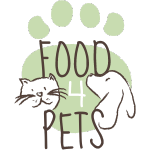Hypoallergenic pet food
Many pet owners are at a loss when their dog or cat gets itchy again or are advised to switch to hypoallergenic food with hydrolyzed protein as the cure-all. Is this justified or are there other ways to make your best buddy wag his tail or purr with joy again?
To answer this, we will first explain to you what exactly hypoallergenic food is.
THE DEFINITION OF HYPOALLERGENIC PET FOOD
*Spoiler: this one doesn't exist.*
As a word, hypoallergenic means "the absence of, or reduced number of, allergens likely to cause an immune response."
In the animal world, this translates to different types of nutrition:
Hypoallergenic food formulated with multiple unique protein sources
A unique protein source is a protein source that is very little used in the usual pet foods. As a result, your buddy is much less likely to have an allergic reaction to it. Research shows that about 2% of dogs, for example, do react to it. Examples of unique protein sources are the combination of venison & rabbit or duck & pheasant.
Hypoallergenic feed formulated with one animal protein source
These foods contain only one source of animal protein, which significantly reduces the risk of an allergic reaction. With these foods you can also start an elimination diet: if your four-legged friend reacts sensitively to many foods, these may be foods that contain different types of animal protein sources. If you give food with only one protein source, such as for example only duck, then you can test which protein source your pet actually reacts to. Examples include horse, camel or trout.
Hypoallergenic food formulated with hydrolyzed proteins
Hydrolyzed proteins are proteins that have been "cut" into small pieces, proteins whose molecules have been additionally split during production. As a result, the body no longer recognizes the proteins as potential allergens, and there is little chance that an allergic reaction will occur in your four-legged friend.


Exactly which proteins are used is then no longer even relevant. Thanks to hydrolysis, a dog or cat that cannot tolerate chicken, for example, can eat food with hydrolyzed proteins from chicken without any problems.
So can your pet not react at all to these types of foods? Unfortunately yes, your four-legged friend may have an intolerance to the many grains or fillers used in these foods. In fact, a fully hydrolyzed food does not exist on the commercial market because this would mean that ALL ingredients would then have to be hydrolyzed, which would make the food extremely expensive and unhealthy for the digestive system.
As you read, a clear definition does not exist, and what is hypoallergenic for one is not at all for another. For example, if your dog or cat can tolerate chicken food just fine, it is a hypoallergenic food for him, while his playmate gets digestive problems from it and for him it is not a hypoallergenic food at all. This makes the term hypoallergenic something very personal.
WHAT THEN TO DISH UP WHEN AN ALLERGIC REACTION IS SUSPECTED?
When your dog or cat:
- Excessive scratching of the groin, armpits or paws (and even dares to bite his paws)
- Skin discoloration has
- Suffers from a lot of dander
- Has gastrointestinal symptoms such as diarrhea and vomiting
- …
And your vet suspects a food allergy, he may recommend trying "hypoallergenic kibble" and starting an elimination diet.
If the symptoms disappear after this, it is effectively also a food allergy.
Elimination diet
In an elimination diet, it is best to choose foods formulated with one animal protein source. This way you can perfectly exclude or add one protein source to your four-legged friend's diet depending on whether or not he reacts to it.
So how do you start up such an elimination diet? Our advice is to start with raw meat food or wet food, combined with probiotics to give the intestines a chance to recover.
You start with a food (protein source) that your dog or cat does not normally eat and cannot normally be allergic to. To give your pet time to completely get rid of his reaction to the old food, you have to give the new food a chance for at least 3 months, stick with it and don't succumb to those cute puppy dog eyes or that lovely purr and still feed him something else. Persevering is the message ;-)
With an allergic reaction to the skin, for example, it may take up to 6 weeks before you will notice improvement. With an allergy that leads to gastrointestinal symptoms, you will be able to notice a difference after only 2-3 days.
Jordy's top tip
Did you know?
Are you feeding a duck-based food? Then also adjust your snacks accordingly and only give snacks with duck. That way you are 100% sure that all possible factors of an allergic reaction are avoided.


Why the combination with probiotics? The good bacteria in probiotics provide gut and digestive support and a real boost to immunity. Especially if a pet has a weakened gut flora, due to diarrhea for example, these good bacteria are lifesavers to bring your four-legged friend's gut back to full balance.
Does even an elimination diet not give you a definitive answer? Then ask your veterinarian for an allergy test. Keep in mind that this blood test is often a snapshot and therefore will not be 100% conclusive.
WHY IT'S BEST TO AVOID HYDROLYZED PROTEINS
So, as you can read above, feeding hydrolyzed foods is not at all necessary and, due to the chemical process of making them, may even be inadvisable.
In theory, the idea it of hydrolyzed pet food seems quite plausible: your dog's or cat's body no longer recognizes the proteins as allergens and will no longer develop a reaction to them.
In reality, there are also some drawbacks:
- The splitting of proteins during production means that your pet's organism will have to take on some of the work that certain enzymes are normally responsible for during digestion.
- Hydrolysis usually destroys the microparticles contained in the protein. In addition, hydrolyzed proteins taste very bitter: a hydrolyzed food without artificial flavors is inedible.
- Hydrolyzed pet foods often use inferior sources of protein such as soy and they are often high in carbohydrates.
And perhaps most importantly, hydrolyzed foods do not address the cause of the problem. In fact, the true causes of food allergies are completely ignored. Instead, these foods try to trick your pet's organism with (often inferior) proteins in order to avoid allergic reactions.








